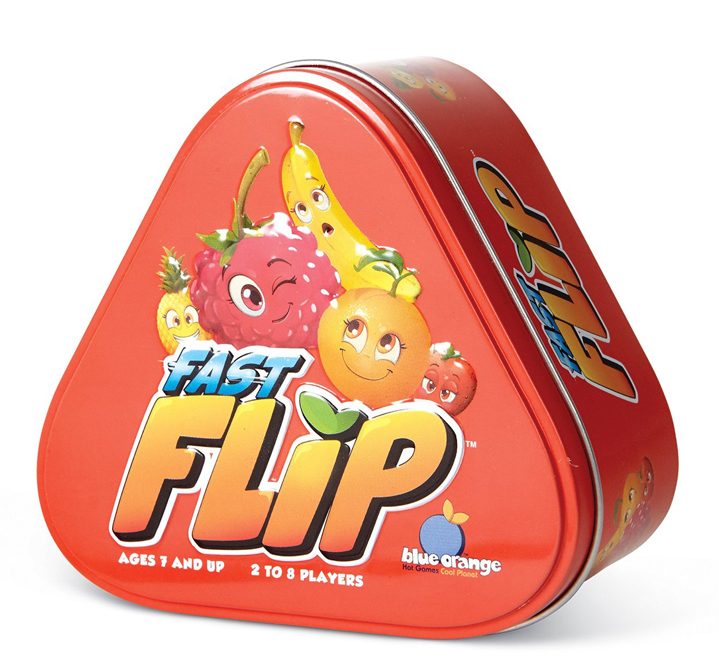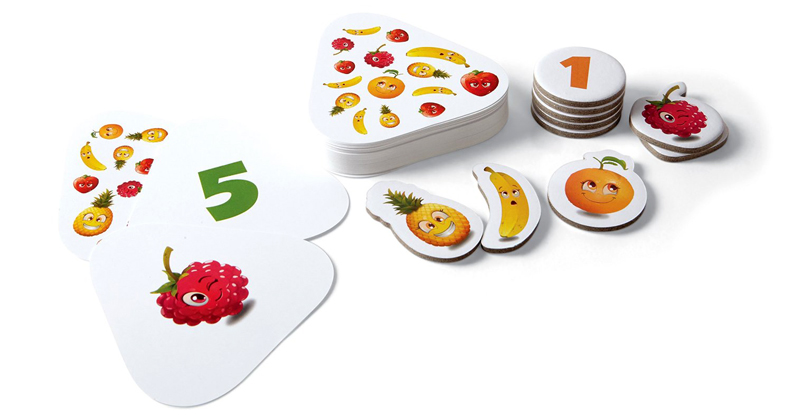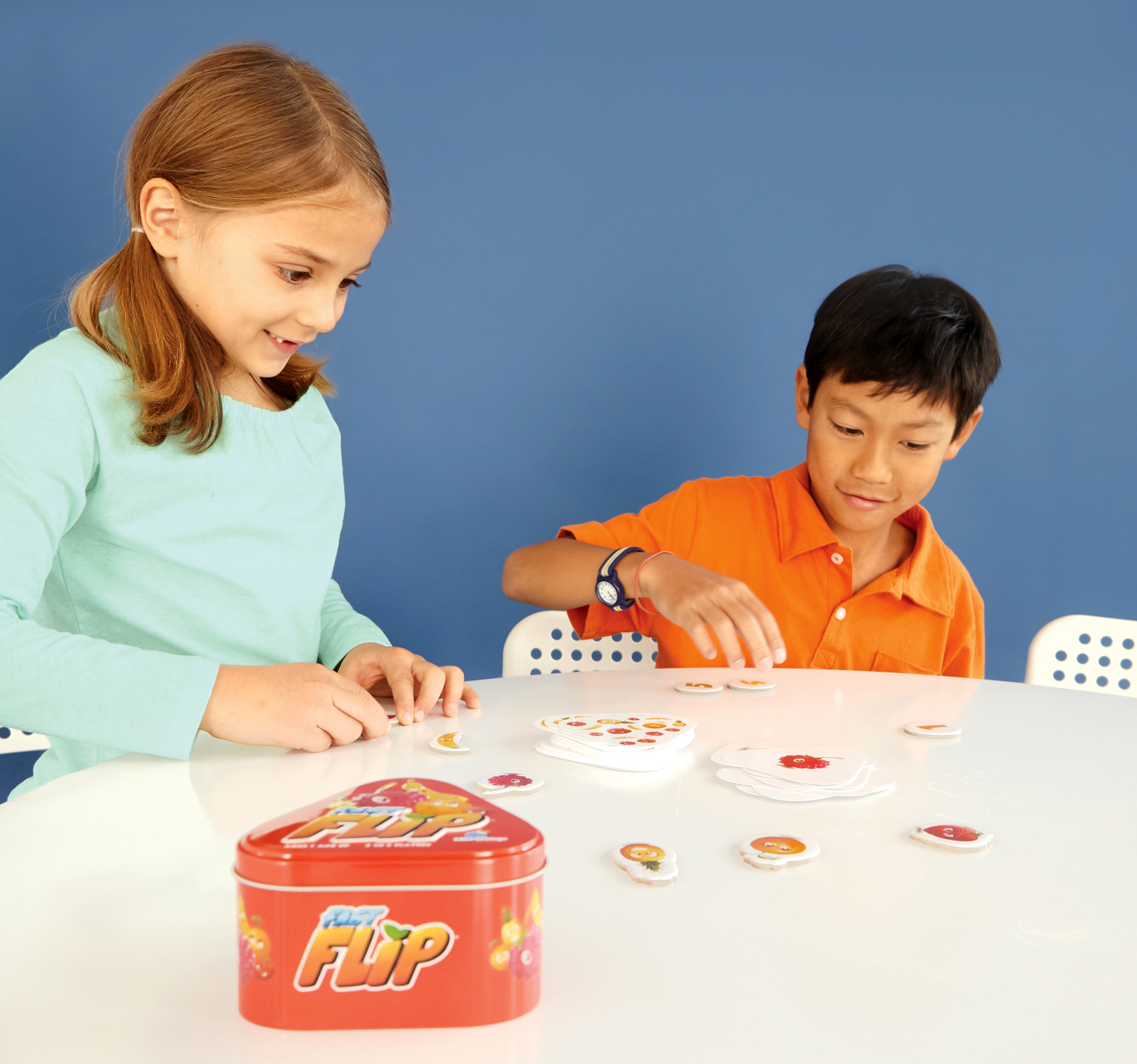My Autism game pick for August is Fast Flip from Blue Orange Games. One of the most notable benefits of the game is that there are many ways to play. As a result, it gives caregivers and therapists a myriad options to customize game play based on each child’s strength and weaknesses. The game is also portable in a compact aluminum tin, making it ideal for storage and bringing from appointment to appointment.
 While Fast Flip is designed for two to eight players ages 7 and up, there are ways to use the cards for younger kiddos, too. With 54 cards, 10 tokens, and a set of rules, the cards sport illustrations on both sides; one side features a single fruit or number illustration, while the other side shows an assortment of different fruits in cute illustrations. The tokens each feature a fruit or number image.
While Fast Flip is designed for two to eight players ages 7 and up, there are ways to use the cards for younger kiddos, too. With 54 cards, 10 tokens, and a set of rules, the cards sport illustrations on both sides; one side features a single fruit or number illustration, while the other side shows an assortment of different fruits in cute illustrations. The tokens each feature a fruit or number image.
In an non-timed way, grownups can ask kids to count how many bananas are on a card to see if they can correctly identify the fruit and can count accordingly. Alternatively, an adult can point to a fruit on the card and see if kids can find the corresponding token. Another small activity is asking children to identify the expressions on the fruit ‘faces’. Use it as a way to recognize emotions and even as an inference activity, “Why do you think the banana looks sleepy?”
 Using one of the official game methods, however, Fast Flip forces kids to utilize visual recognition and awareness skills in order to win the game at hand.
Using one of the official game methods, however, Fast Flip forces kids to utilize visual recognition and awareness skills in order to win the game at hand.
One way to play Fast Flip is a game called ‘Token Grab’. As stated in The Toy Insider’s Expert Review, all the cards are placed face down and the top card in the deck is flipped over to reveal a medley of fruits. This exposes a new top card with a single fruit or number on it. If the new top card in the pile shows a fruit, players must quickly identify how many of that fruit appear on the new face up card and grab the number token to match. If the new top card shows a number, players must quickly determine which fruit appears that many times on the face up card and grab the fruit token to match.
Each round requires some pretty quick thinking and reflexes to come out on top. For children on the spectrum, start slow by letting the child play with your guidance, in order to minimize frustrations. As he or she gains confidence and skill in the game, invite a model peer to play, working another player (and challenge) into the mix. It is a way to test the social and behavioral triggers, and work on them accordingly.
 In the Token Grab version, taking tokens from another player is both encouraged and necessary. If a player has earned a token (and a point), it doesn’t mean it’s out of play. If an opponent’s token is the answer to any other card flip, all players are free to grab it if they have the chance. This can trigger aggressive behaviors and responses for many children on the spectrum. However, that many not be a bad thing if you use it as a teaching opportunity to help children on the spectrum not react to other individuals’ ‘negative’ behaviors. Yet, this method of play would not be suggested for children with impulse controls as it would encourage the behavior. Caregivers and therapists should consider all options before using this method of the game.
In the Token Grab version, taking tokens from another player is both encouraged and necessary. If a player has earned a token (and a point), it doesn’t mean it’s out of play. If an opponent’s token is the answer to any other card flip, all players are free to grab it if they have the chance. This can trigger aggressive behaviors and responses for many children on the spectrum. However, that many not be a bad thing if you use it as a teaching opportunity to help children on the spectrum not react to other individuals’ ‘negative’ behaviors. Yet, this method of play would not be suggested for children with impulse controls as it would encourage the behavior. Caregivers and therapists should consider all options before using this method of the game.
One suggestion is to lay out all the tokens in a center spot. When the token is identified as the answer to the card, have the child ‘point’ or pick up the token, but have them put it back in the center. This way, it does not feel like the token is being ‘taken’ away from said child. Have a white board nearby and give the child a check mark, a point, (or even draw the fruit!) next to their name if they were first to get the answer. At the end of the game, see how many points each player has on the central white board to win the game.
Fast Flip can be challenging in other ways, too. The fruits, which consist of a banana, a strawberry, a raspberry, an orange, and a pineapple, are relatively similar in color. Sometimes the yellow bananas get mistaken for yellow pineapples, which can be frustrating for some children. However, it is an opportunity to work on identification and appropriate responses.
Overall, Fast Flip is a great way to work with kids on the spectrum in the areas of math, logic, and spatial skills, let alone other social and behavioral skills. Its quick gameplay makes it easy to start and finish a game in no more than 15 minutes, making it ideal for children with attending issues too.
